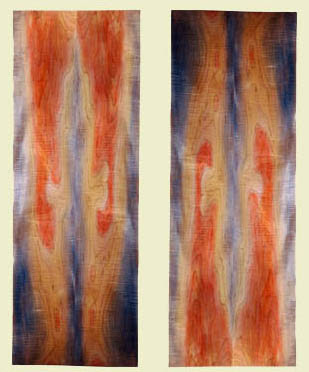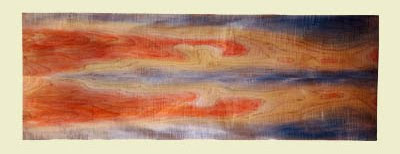 With the following dimensions:
With the following dimensions: The client had bought "Thrice in a Lifetime" at the Paradise City show in October for the space but it really didn't work, as I realized when I saw the image of the location. In addition to being a large, odd shaped wall, it also starts 10 feet above the floor, so a 3' x 3' piece would get totally lost. They wanted to know if they could exchange what they had for something that fit better and I told they they could. The specific request was to "draw up some ideas for a special order shellac painting piece (perhaps something shell-like)." Since the client had previously asked about doing something shell-like, I felt the emphasis was really on shell-like and not on a general abstract piece.
The client had bought "Thrice in a Lifetime" at the Paradise City show in October for the space but it really didn't work, as I realized when I saw the image of the location. In addition to being a large, odd shaped wall, it also starts 10 feet above the floor, so a 3' x 3' piece would get totally lost. They wanted to know if they could exchange what they had for something that fit better and I told they they could. The specific request was to "draw up some ideas for a special order shellac painting piece (perhaps something shell-like)." Since the client had previously asked about doing something shell-like, I felt the emphasis was really on shell-like and not on a general abstract piece.At first, I was confused about how I could apply what I do to make something that would be considered "shell-like." I didn't want to do any carving and all I could think of were scallops. Then I realized that gastropods, cephalopods, and the like, create sea-shells and that it might be possible to create a flat projection of something along those lines.
After spending a couple of days looking at thousands (no exaggeration) of shell images, primarily from this site, this one (94,199 shells for sale and I think I saw them all), and this one; I decided to go with something along the lines of this and this. The great thing about working in the parameters of something "shell-like" is that the diversity of shapes and colors are so great that there is an enormous amount of flexibility. Had they asked for a dog, whale, or some other figurative object, I probably would have refused, but shells, they seem to work with what I already do.
So I started drawing, and struggling with creating something that fit the space proportionally. Here are my series of drawing, in the approximate order they were created (I know it is a lot to post but I think it is interesting how they go from something rough and horrible to something that actually might work):




After I drove by a Shell station I realized that I could create an art deco stylized scallop-like shell but then realized it really wouldn't fit the space very well. I also didn't like its perfect symmetry, although shells like this and this are really captivating.
 Some shells are somewhat angular but I thought it would be too "hard" for the space.
Some shells are somewhat angular but I thought it would be too "hard" for the space. 






 Finally, I was happy with a drawing. I just needed to recreate a clean version, which I did below:
Finally, I was happy with a drawing. I just needed to recreate a clean version, which I did below: I suggested that it might look best in flame yellow birch, which I picked up recently, because both the grain and the figure are larger than maple and could be seen better from a distance; and that the stripes could be made with walnut because it would contrast better with the yellow birch than cherry would. I also thought that the tip could be gilded in order to draw more attention to the top and make it more visible from a distance (about 17' high).
I suggested that it might look best in flame yellow birch, which I picked up recently, because both the grain and the figure are larger than maple and could be seen better from a distance; and that the stripes could be made with walnut because it would contrast better with the yellow birch than cherry would. I also thought that the tip could be gilded in order to draw more attention to the top and make it more visible from a distance (about 17' high). As shown in the cross-section drawings, the edges will be rounded, there will be a small gap between the sections (eight total), and the sections will be joined with a backing that will be screwed into each side.
As shown in the cross-section drawings, the edges will be rounded, there will be a small gap between the sections (eight total), and the sections will be joined with a backing that will be screwed into each side.I'm hoping to finish the piece by sometime in November. Luckily, the clients are flexible about the schedule so that I can have time to finish some new pieces for the shows I'm going to in September and October. I've started milling the wood that I have and the figure in the yellow birch should be perfect for this application, really big and dramatic. However, I'm a little short on what I need so I have an excuse to go to the lumber mill on Monday to pick up some more birch, walnut, and what ever else looks interesting. Always good to have an excuse to go to the mill.








